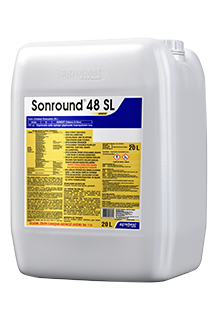
SONROUND 48 SL
Glyphosate I.P.A. Salt

Glyphosate I.P.A. Salt
Water soluble concentrate
Group – G
Herbicide
USED PLANTS AND WEEDS
| Name Plant | weed name | Consumption rate | Application period |
| citrus, grapes, fruit parks and cultural harvest uncultivated fields |
Annuals and perennials prickly and dicotyledonous against weeds |
5 l/ha | Weeds are young and during active growth (The cotton is planted from landing in the fields first, when landing or after landing can be used. However, it’s completely normal. from germination need to be treated) |
| Roads, railway edges, factory factory gardens, historical places, airports, fields edges, etc. |
Grows in bushes and woody plants |
10 l/ha | weeds during active growth |
| Road edges, water and drainage channels |
road and water weeds on it |
10-15 l/ha | weeds during active growth |
METHOD OF APPLICATION
Best results are achieved with active weed growth. Make sure that the mixture does not get on the body parts of cultivated plants and green parts of young seedlings. Since Sonround 48 SL is a systemic plant protection agent, agrotechnical measures in the field cannot be carried out for at least 4-5 days after application. The ideal amount of water per hectare is 200-400 liters. Processing should be carried out during the cool hours of the day, when there is no wind or light wind.
RESISTANCE INFO
Crop protection Sonround 48 SL is classified as a group G herbicide by mechanism of action. Repeated use of a plant protection product with the same mechanism of action will increase plant resistance. Therefore, to reduce drag, do not exceed the amount of Sonround 48 SL that should be used in one season. In cases where it is necessary to repeat the treatment, pay attention to the use of plant protection products with a different mechanism of action (except for group D).
DRUG COMPATIBILITY:
Do not mix with other plant protection products.